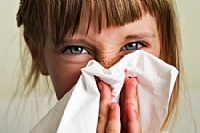 It’s winter again and along with it come colds, flu, and chronic sinus and upper respiratory symptoms from cold and damp weather. Winter can also increase your physical reaction to something you may mistake for a cold or chronic sinus infection. The something I’m referring to is dust mite – that microscopic bug that lives in your pillows, mattress, bedclothes, furniture, and carpet. You may be allergic to them and not know it. Let me tell you more about these strange creatures and what you can do to keep them away from you.
It’s winter again and along with it come colds, flu, and chronic sinus and upper respiratory symptoms from cold and damp weather. Winter can also increase your physical reaction to something you may mistake for a cold or chronic sinus infection. The something I’m referring to is dust mite – that microscopic bug that lives in your pillows, mattress, bedclothes, furniture, and carpet. You may be allergic to them and not know it. Let me tell you more about these strange creatures and what you can do to keep them away from you.
Winter Cold or Dust Mite Allergy?
Although dust mites are present year-round, they can really multiply in winter. When furnaces come on, dust and dust mites increase everywhere. In winter, dust mites (and their allergenic feces) can be present in your home in the millions!
Here are some surprising facts about dust and its mites, from the Environment Health and Safety organization:
- Dust mites feed on human skin scales and animal dander.
- Nearly 100,000 dust mites can live in 1 square foot of carpet. A mattress can contain millions of them.
- 1 dust mite produces about 20 waste droppings a day. These droppings consist of a protein to which many humans are allergic.
- Symptoms of dust mite allergy can include itchy skin rashes, itchy eyes, asthmatic attacks, chronic sinus drainage, sneezing, postnasal drip, chronic cough, nasal congestion, chronic under-eye swelling (bags), and nasal polyps that need surgical removal. Also, headache, fatigue and depression. These symptoms are frequently mistaken for colds.
- 18% to 30% of people have known dust mite allergies. Another 50% have very high dust mite allergen levels in their homes. These can create dust mite allergies in people who’ve never before had one. Being more house-bound in winter can also cause these allergies to flare in their symptoms dramatically.
- House dust is one of the most highly toxic substances around. In addition to dust mite feces and their cast off skin shells, house dust contains toxins like cigarette and incinerator ash, combustion products, insect fragments, human and animal hair and nails, pollen, polymer foam particles, fungi, molds, bacteria and viruses.
How Can You Keep Dust Mites Away From You?
It’s pretty near impossible to get rid of all the dust mites in your living environment, especially in winter. Yet, researchers from the University of Nebraska, who have specifically studied dust mites, recommend that you can create barriers between you and dust mites.
1. Keep it clean. First, and foremost, keeping your home as free of dust buildup as possible. In the winter, spray a dust mop with a dust-attracting furniture polish, or just water, and run it under beds on hardwood or tile floors. Keep furniture, blinds and curtains as dust free as possible as well. Sanitizing steam mops help kill dust mites and bed bugs on floors. Pesticide-free products that contain benzyl benzoate also help kill dust mites.
2. Encase it. Encasing your pillows and mattress with zipped plastic covers. This is the only way to keep dust mite feces away from you as you sleep. Wash these covers once a year with hot water. If you travel and stay in hotels, you may want to take an extra set of cases with you. Manufacturers of memory foam mattresses claim that their material is not favorable to dust mites. A water proof cover also keeps out bed bugs (a growing problem).
3. Launder. Keep your sheets, blankets, pillowcases, clean. Launder every 2 weeks in very hot water, at least 120-130 degrees.
4. Leave bed unmade: Pull back your bed covers, sheets and let your sheets, blankets air out, especially if you tend to sweat at all during sleep.
5. Humidity/Heat. Dust mites thrive in more humid and warmer conditions, so try and keep your home a little drier and cooler. Humidity should be below 50% to cut down on dust mites. Run your dehumidifier at least once or twice a week.
6. HEPA filter. Installing one on your furnace can really cut down on dust output through your home.
7. Let in the light. UV rays can help keep down dust mite populations as well. Especially on sunny winter days, open the curtains, blinds, and allow some light into your bedroom.
What Else Can You Do?
If you experience many of the symptoms listed above, it may not be a winter cold or flu. It could possibly be a chronic dust mite allergy. Your doctor can draw your blood to see if you have high RAST levels, which indicate you are probably reacting to an allergen in your environment. Secondly, an allergist can test you for dust mite. A skin prick scratch test is done on your back. Over 100 known allergens are then placed into these scratches and results evaluated.
Though dust mites, and their symptoms, can be unwelcome house guests, if you follow the simple recommendations above, I believe you can get your dust mite guests – and your chronic symptoms under control. You may vanish your chronic winter cold for good.
Stay Well,
Mark Rosenberg, M.D.
Natural Health News
Dust Mites, Everything You Might Not Want to Know, http://www.ehso.com/ehshome/dustmites.php
Indoor Allergies Relief, http://www.acaai.org/allergist/allergies/Types/dust-allergy-information/Pages/indoor-allergies-relief.aspx
Dust Mite Allergy and Fatigue, http://www.momswhothink.com/diet-and-nutrition/dust-mite-allergy-and-fatigue.html
photo credit: zenherbs.co.il
